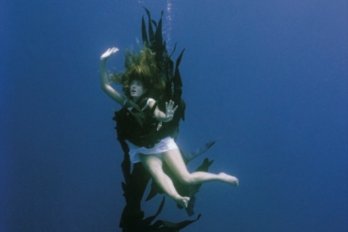danang—“Charlie don’t surf – but you can,” promises the Internet brochure for the U.K.-based Wild Frontiers “Apocalypse Now 2004” tour of Vietnam, Cambodia, and Laos. The line is a paraphrase from a scene in the Francis Ford Coppola classic, just before the famous Ride of the Valkyries helicopter assault, when Robert Duvall’s Colonel Kilgore levels a Vietcong village after sneering about “Charlie,” his North Vietnamese enemy. Now, tourists are being invited to “surf on China Beach” – like, presumably, the hapless grunts in the movie forced by their commanding officer to mount their boards as shells explode around them – even though the location where that scene in the movie was shot is somewhere else.
For many in the West, the name China Beach, coined by flippant soldiers who landed here almost forty years ago, was further enshrined in war lore by the TV show of the same name, set in an American evacuation hospital. In his 1977 book Dispatches, Michael Herr writes about the battle-weary marines sent for R&R on the “great curving stretch of beachfront” adjacent to Danang. “They would splash in the surf,” Herr reports, “giggling and shouting, riding beach disks along the shoreline, playing like kids.” The men often then returned to some of the conflict’s bloodiest battles, at nearby Hue and Khe Sanh and in the A Shau Valley. The wounded convalesced in the hospitals and the dead were shipped home from Danang airfield, reputed to have been one of the busiest runways on the planet.
Landing in March at that same airfield, now a modest airport with a couple of international flights per day, I set off to explore Vietnam’s relationship with its famous strand.
Out on the pristine arc, with its soft-as-brown-sugar sand running thirty kilometres from a mountain to the north to a cluster of hillocks to the south, I admire the stretch described by the customer-relations person at the Furama Resort, the only international hotel in the area, as our “private China Beach.” A cab driver has already put the beach closer to town, while a local man who rents chairs is convinced the real China Beach lies “down there,” below the Furama. He gives it a Vietnamese name – Non Nuoc.
The name of the beach and the conflict it came from are points of contention for Vietnam’s tourism industry.
The country withdrew into a socialist shell after unification in 1975, re-emerging only in the last decade. Hanoi and Ho Chi Minh City (formerly Saigon) have become established destinations, while more intrepid travellers, riding the trains or daring to take the buses, are making more popular the demilitarized zone (DMZ), the imperial capital of Hue, and the postcard town of Hoi An.
Danang, though, remains off the beaten path, despite those thirty kilometres of idyllic beach. As I stride down city sidewalks crowded with noodle stalls and outdoor restaurants, every other shop a cyber café or coffee house, mothers actually lift their children up to get a better look at me – a rare Westerner. While there are plans to develop other resorts along China Beach, for now the seven-year-old Furama owns the international market. Its clientele, I am told, are mostly French tourists keen to revisit their colonial past, along with American groups who, says a British engineer familiar with the Furama, “come back to dig for MIA bones in the jungle.”
Danang and its beachfront are dealing with these wartime associations by promoting a region where many “strategic battles” have been fought throughout history, the director of Danang tourism, Luong Minh Sam, recently said, “but American tourism is really our aim.” The official confessed to some unease about referring to the beach by its foreign nickname. “For years we didn’t use the name,” he admitted. “But now we see the benefit.”
My guide, whom I’ll call Quang Duc, was born two years after the fall of Saigon. His father worked for the Americans at the airfield, a job that cost him a bout in a re-education camp followed by fifteen years’ unemployment, during which time his family barely survived. At just twenty-six, Quang Duc is already the clan breadwinner, a task he accepts with Confucian grace. He is bright and earnest, and has excellent English thanks to his father’s tutoring.
As we drive to the Marble Mountains for a bird’s-eye view of the strand, Quang Duc explains the government campaign to stop the reappearance of pre-1975 licentiousness in the cities. “In Danang there are the ‘Five Nos,’ ” he says. “No murder, no beggars, no illiteracy, no hunger, and no heroin.” In nearby Hoi An, there are three extra ones: no massage, no karaoke, and no women working in “hair salons,” a popular front for brothels.
We climb Water Mountain, tallest of the five limestone outcrops. According to legend, the hillocks represent the elements, the others being earth, wind, fire, and metal. On the way to the look-out we visit a shrine to a female deity, where Quang Duc relates a Vietnamese creation myth. Then we stop in a cavern that houses a miniature temple, complete with its own stone guards. Blue sky shows through gaps in the cavern roof, courtesy of the shells fired on it to flush out hiding Vietcong.
I want him to point out where the dozens of American military installations were – the marine-corps units, helicopter bases, and special-forces com-pounds. But Quang Duc is more interested in stories about his favourite gods or historical figures such as Minh Mang, the emperor who built many of the temples and lived in the palace at Hue. Minh Mang had three-hundred-and-sixty-five wives, Quang Duc says, one for each day of the year. “He must have been tired,” he speculates.
After climbing through a gap in the rocks, we gaze down on the South China Sea. Quang Duc lists the names of the separate beaches. Below us is Non Nuoc, where U.S. officers had a facility. Further up, past a former helicopter base, is Bae My An, followed by My Khe, which incorporates the city swimming areas. Towards the north, closer to Nui Khi, or Monkey Mountain, are beaches he knows only as T.18 and T.20. These are present-day Vietnamese military installations. Local names for local places.
I wonder about the development schemes. Quang Duc shows me where resorts are slated to be built, including a golf course adjacent to the Furama. But he has his doubts. “Corruption,” he says with a shrug, ignoring the dozens of sightseers gathered around us, keen to eavesdrop on a conversation they can’t follow. “And poverty,” he adds.
Quang Duc says he isn’t bothered by my questions about the American facilities, or by the use of the name “China Beach.” His heart, though, clearly isn’t in a U.S. military tour of the region where he has spent his entire life. He’d much rather talk about emperors and goddesses and the need for better roads and higher morals.
Still, I ask one more question. His face goes blank at the movie title and he struggles with the peculiar word, which he has never heard before. “A-pock-lips?” he asks. “A kind of prophecy,” I answer. “Usually of doom and destruction.” He asks about the film, but I say it doesn’t matter. It was someone else’s beach, and someone else’s war.






